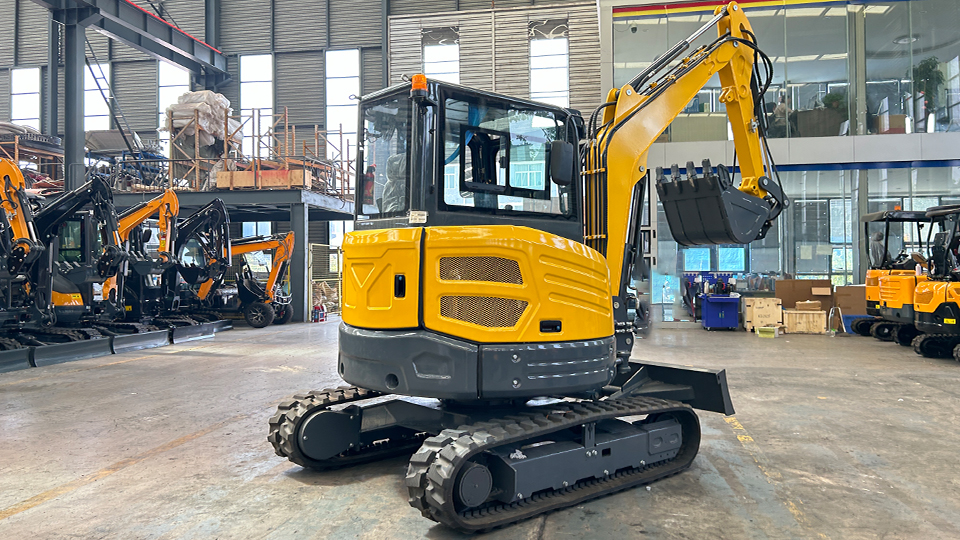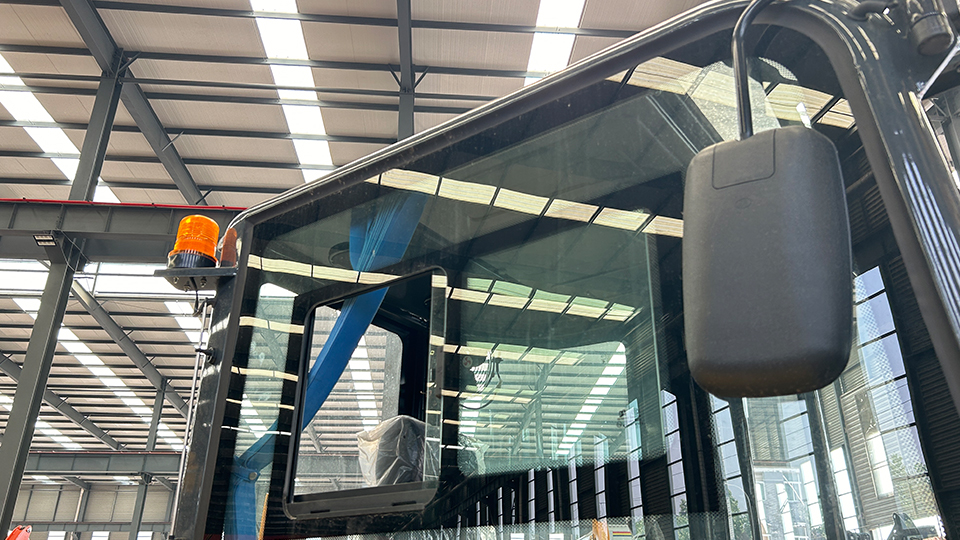Abstract
Excavators are indispensable heavy machines for a myriad of earthmoving, demolition, and construction tasks. For businesses and individuals undertaking short-term projects, purchasing an excavator is often economically unfeasible and impractical. Renting provides a flexible and cost-effective alternative. This article will delve into the critical factors to consider when deciding whether to rent an excavator, offering practical tips and technical considerations to ensure a successful and efficient short-term project. We will cover project assessment, machine selection, logistical planning, and essential safety protocols.
1. Introduction: The Role of Excavators in Construction and Project Needs
1.1 What is an Excavator?
Briefly describe an excavator: a heavy construction equipment consisting of a boom, dipper (or stick), bucket (or other attachment), and a cab on a rotating platform (superstructure) with tracks or wheels.
Mention its primary functions: digging trenches, foundations, holes; demolition; material handling; grading; landscaping.
1.2 Buy vs. Rent: The Core Dilemma:
Introduce the fundamental question faced by project managers and contractors: acquiring equipment through purchase or rental.
Highlight the high capital cost of purchasing heavy machinery.
Introduce rental as a viable, flexible solution for specific project scenarios.
1.3 Scope of This Article:
Focus on short-term projects (typically days to a few weeks, sometimes up to a couple of months).
Emphasize practical advice and technical considerations for making informed rental decisions.
2. When to Rent: Identifying Short-Term Project Characteristics

This section defines the ideal scenarios for excavator rental.
2.1 Infrequent or Sporadic Use:
If excavator use is not a daily or weekly necessity for your core business.
Examples: seasonal landscaping, occasional foundation work, specific utility repairs.
Technical Implication: Purchasing for infrequent use leads to rapid depreciation, high storage costs, and underutilization of a high-value asset.
2.2 Specialized Job Requirements:
When a project demands a specific type or size of excavator not typically part of your existing fleet.
Examples:
Mini-excavator for tight access areas (e.g., backyard landscaping, indoor demolition).
Large excavator for a single, deep excavation or mass earthmoving project.
Excavator requiring a specialized attachment (e.g., hydraulic hammer, auger, grapple) that you don't own.
Technical Implication: Rental allows access to diverse equipment without the capital expenditure for specialized, infrequently used machinery.
2.3 Unforeseen Project Demands or Emergency Situations:
Responding to unexpected work that requires immediate heavy equipment (e.g., burst water main, emergency demolition, site clearing after a storm).
Technical Implication: Rental companies offer rapid deployment, crucial for time-sensitive projects.
2.4 Pilot Projects or Testing New Workflows:
Trying out a new type of project or expanding into a new service area without committing to a full purchase.
Technical Implication: Lowers financial risk for new ventures.
2.5 Financial Flexibility and Capital Preservation:
When capital is better allocated to other business areas (e.g., payroll, materials, marketing).
Avoids tying up lines of credit or requiring large down payments.
Technical Implication: Converts a significant capital expenditure (CapEx) into an operating expense (OpEx), offering tax benefits and improved cash flow.
3. Assessing Your Project Needs: The First Critical Step
Before contacting a rental company, a thorough project assessment is paramount.
3.1 Define the Scope of Work:
What exactly needs to be done? (e.g., dig a 100-foot trench 3 feet deep, clear 1 acre of brush, demolish a small shed).
Technical Detail: Quantify the volume of material to be moved (m
3or yd 3 ), the depth of excavation, the size of demolition targets.

3.2 Site Conditions Analysis:
Terrain: Rocky, sandy, clay, wet, sloped? This influences machine power and track/wheel choice.
Access: Is the site easily accessible for delivery and the excavator itself? Are there narrow gates, low overhead clearances, soft ground?
Underground Utilities: Crucial for safety. Have utility locates (e.g., 811 in the US) been performed and marked? This dictates digging methods and potentially machine size/force.
Overhead Obstructions: Power lines, tree branches, building overhangs. Affects boom reach and swing radius.
Technical Implication: Proper site assessment prevents machine breakdown, damage, project delays, and accidents.
3.3 Required Attachments:
Beyond the standard digging bucket, what else is needed?
Examples:
Hydraulic breaker/hammer: for concrete or rock demolition.
Auger: for drilling post holes or pilings.
Grapple: for brush clearing, demolition debris sorting.
Compactor wheel/plate: for trench backfilling.
Ripper: for breaking up hard ground.
Tiltrotator: for advanced grading and precision work.
Technical Implication: Attachments can significantly enhance versatility and efficiency but must be compatible with the excavator's hydraulic flow and lifting capacity.
3.4 Project Timeline:
How long will the excavator realistically be needed? Be realistic and factor in potential delays.
Technical Implication: Rental rates typically decrease with longer rental periods (daily, weekly, monthly). Accurate estimation optimizes cost.
4. Choosing the Right Excavator Size and Type
This is where the technical details of machine selection come into play.
4.1 Mini-Excavators (Mini-Ex / Compact Excavators):
Size: Typically 0.5 to 8 metric tons operating weight.
Pros: Excellent maneuverability in tight spaces (e.g., backyard gates, indoor demolition), minimal ground disturbance (rubber tracks), easy to transport (some can be towed by a heavy-duty pickup).
Cons: Limited digging depth and reach, less power for heavy breaking or large-scale earthmoving.
Typical Applications: Landscaping, utility trenching, interior demolition, plumbing repairs, small foundations.
4.2 Medium Excavators:
Size: Typically 8 to 25 metric tons operating weight.
Pros: Good balance of power, reach, and maneuverability. Versatile for a wide range of tasks.
Cons: Requires professional transport, larger footprint.
Typical Applications: Mid-sized foundations, general site work, road building, larger utility projects.
4.3 Large Excavators:
Size: 25 metric tons and up.
Pros: Maximum digging depth, reach, and lifting capacity. Ideal for mass excavation and heavy demolition.
Cons: Very large footprint, challenging to transport, high operating costs.
Typical Applications: Quarrying, large-scale commercial/industrial construction, deep utility lines, major infrastructure projects.
4.4 Wheeled Excavators (Rubber-Tired Excavators):
Pros: High mobility on paved surfaces, can travel between sites without a trailer (in some cases), less ground damage.
Cons: Less stability and traction on soft or uneven terrain compared to tracks, typically higher ground pressure.
Typical Applications: Road construction, urban utility work, operations requiring frequent movement on hard surfaces.
4.5 Factors Influencing Size Selection:
Digging Depth & Reach: Matches the required dimensions of your excavation.
Breakout Force: Necessary for challenging materials (e.g., hard clay, rock).
Lift Capacity: For handling heavy objects (e.g., pipes, concrete slabs).
Tail Swing (Conventional vs. Zero/Reduced Tail Swing): Crucial for confined areas. Zero/Reduced Tail Swing excavators prevent the rear of the machine from extending significantly beyond the tracks, reducing collision risk in tight spots.
Hydraulic Flow: Ensures compatibility with desired hydraulic attachments.
5. The Rental Process and Key Considerations
Navigating the rental agreement and logistics.
5.1 Reputable Rental Companies:
Look for companies with a wide inventory, well-maintained equipment, transparent pricing, and good customer service.
Check online reviews, industry reputation.
5.2 Understanding Rental Agreements:
Rental Period: Daily, weekly, monthly rates – calculate the most cost-effective option based on your timeline.
Operating Hours: Most rentals include a set number of operating hours per day/week/month (e.g., 8 hours/day). Overtime hours incur additional charges. Understand how this impacts your project schedule.
Fuel Policy: Typically, you receive the machine full and return it full, or charges apply. Propane/diesel.
Insurance: Crucial. Your existing business insurance might cover rented equipment, or you may need to purchase a damage waiver or rental insurance from the rental company. Understand deductible and coverage limits.
Delivery and Pickup: Costs associated with transportation to and from your site. Confirm access routes and staging areas.
Maintenance and Repairs: Clarify who is responsible for routine maintenance (e.g., daily checks) versus major repairs (usually the rental company unless damage is due to negligence).
5.3 Operator Qualifications:
Most rental companies require proof of operator competence.
Ensure your operator is properly trained and certified (e.g., OSHA regulations in the US, local equivalents).
Technical Implication: Untrained operators can cause damage to the machine, the property, or severe accidents.
5.4 Pre-Operation Inspection:
Walk-Around Inspection: Before accepting delivery or starting work, thoroughly inspect the machine. Document any existing damage (photos/video) to avoid being charged.
Fluid Levels: Check engine oil, hydraulic fluid, coolant.
Tracks/Tires: Inspect for damage or excessive wear.
Attachments: Ensure secure mounting and proper function.
Safety Features: Test lights, horn, backup alarm, emergency stops.
Technical Implication: A proper inspection ensures the machine is safe and functional, and protects you from liability for pre-existing issues.
6. Safety Protocols and Best Practices
Operating heavy machinery always carries inherent risks.
6.1 Site Safety Plan:
Develop a plan for excavator operation: designated operating zones, swing radius clearances, exclusion zones for personnel.
Identify potential hazards (e.g., overhead lines, underground utilities, unstable ground, adjacent structures).
6.2 Utility Locates (Mandatory):
Call 811 (or your regional equivalent) days in advance to have underground utilities marked. Dig Safely!
Technical Implication: Striking gas lines, electrical cables, or water pipes can lead to explosions, electrocution, or catastrophic property damage.
6.3 Personal Protective Equipment (PPE):
Hard hat, safety glasses, high-visibility clothing, steel-toed boots, gloves.
6.4 Operator Training and Competence:
Only authorized, trained, and competent operators should be allowed to operate the excavator.
6.5 Daily Machine Checks:
Perform a pre-shift inspection: fluid levels, hoses, connections, tracks/wheels, attachments, lights, alarms.
Technical Implication: Prevents breakdowns and ensures safe operation throughout the workday.
6.6 Communication:
Establish clear communication protocols with ground personnel (e.g., hand signals, two-way radios).
6.7 Environmental Considerations:
Proper disposal of waste materials.
Spill prevention and cleanup plans for fuel or hydraulic fluid.
7. Financial Considerations and Cost Optimization
Breaking down the economics of renting.
7.1 Direct Costs:
Rental rate (daily/weekly/monthly).
Delivery/pickup fees.
Fuel consumption.
Attachment rental fees.
Insurance/damage waiver.
Operator wages.
Environmental fees (if applicable).
7.2 Hidden Costs of Ownership (Avoided by Renting):
Initial capital outlay.
Financing interest.
Depreciation.
Long-term storage costs.
Regular maintenance and unexpected repair costs.
Insurance (long-term policy).
Transportation for all projects (if you own).
Resale value fluctuations.
7.3 Cost-Benefit Analysis:
For short-term projects, the sum of rental direct costs is almost invariably less than the prorated costs of ownership.
Focus on total project cost, not just the hourly rate. An efficient, slightly more expensive machine that finishes faster can be cheaper overall.
8. Conclusion: Maximizing Efficiency and Safety Through Strategic Rental
Renting an excavator for short-term projects is a strategic decision that offers unparalleled flexibility, cost-effectiveness, and access to specialized equipment without the burdens of ownership. By meticulously assessing project needs, choosing the right machine size and type, understanding the rental agreement, and adhering to rigorous safety protocols, contractors and project managers can significantly enhance efficiency, minimize risks, and successfully complete their short-term earthmoving tasks. The key lies in informed planning and leveraging the expertise of reputable rental partners to ensure that the powerful capabilities of an excavator are precisely matched to the specific demands of the job at hand.
Post time:Sep-25-2020
